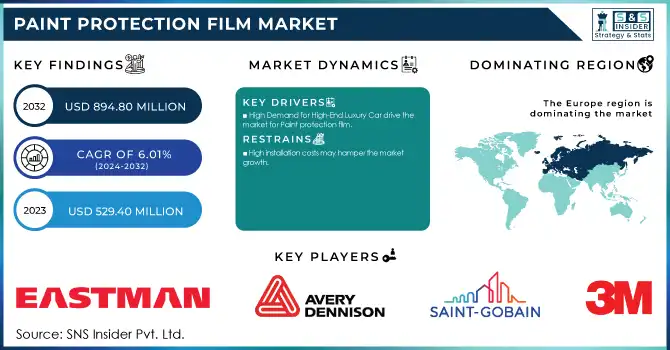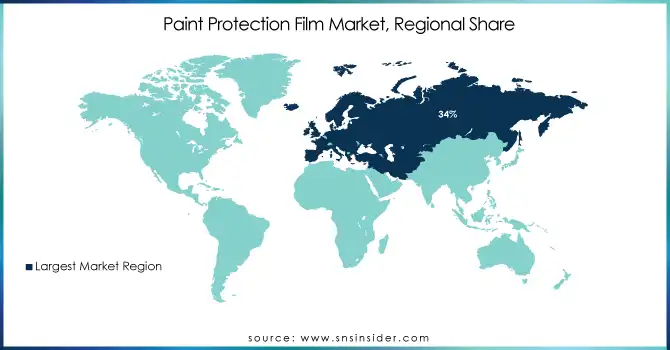Paint Protection Film Market Report Scope & Overview:
The Paint Protection Film Market size was USD 529.40 Million in 2023 and is expected to reach USD 894.80 Million by 2032 and grow at a CAGR of 6.01 % over the forecast period of 2024-2032.

Get E-PDF Sample Report on Paint Protection Film Market - Request Sample Report
The global paint protection film (PPF) market is mainly attributed to the increasing vehicle aesthetics demand. This is particularly true for the luxury and sports car owner who has become a more discerning keeper of his or her car, wanting to retain the fit, finish, and resale value of the vehicle. PPFs offer a high-end option for keeping all those scratches, chips, stains, and UV damage away from your vehicle's exterior while retaining the factory paint finish. With increasing disposable incomes and an upsurge in the number of consumers preferring vehicles personalized, consumers are looking for an advanced protective film that not only provides protection but also enhances the beauty of the vehicle. The trend is also supported by the rising number of luxury vehicles in developing markets, where keeping a new car looking as good as new is a major concern for a lot of owners.
According to the Second Advance Estimates of National Income, 2022-23, released by the Ministry of Statistics and Programme Implementation, India's per capita net national income at current prices was estimated at ₹1,50,906 for 2021-22 and ₹1,69,496 for 2022-23, indicating a rise in disposable incomes.
Advancements in film technology have significantly contributed to the growth of the Paint Protection Film (PPF) market. Over the years, manufacturers have developed highly sophisticated films with enhanced features that offer superior protection and performance. Modern PPFs are equipped with self-healing properties, allowing them to recover from minor scratches and abrasions when exposed to heat, thus ensuring long-lasting protection and maintaining the vehicle's aesthetic appeal. Additionally, these films now come with increased resistance to UV rays, which helps prevent discoloration and fading of the vehicle's paint. Innovations have also led to the creation of thinner, more flexible films that provide better coverage without compromising on durability or clarity. These technological advancements not only improve the functionality of PPFs but also make them more attractive to consumers, driving their widespread adoption across various vehicle segments.
Paint Protection Film Market Dynamics
Drivers
-
High Demand for High-End Luxury Car drive the market for Paint protection film.
One of the major factors driving the Paint Protection Film (PPF) market is the growth in the need for high-end luxury cars. With the increase in consumers' wealth, especially from the emerging markets, the market for luxury and premium vehicles is booming. Luxury or expensive car owners focus on maintaining the looks and value of their cars and look for long-term protective products. PPFs have emerged over recent years as the only credible solution to protect luxury car owners' paintwork against damage from vagaries of road debris, scratches, UV rays , and other factors. Predictably, these films tend to be particularly favored by owners of Ferrari, Lamborghini, and Porsche vehicles especially since they help keep the car looking showroom new, thus increasing its resale value. Luxury car buyers very much want solutions that are designed to not only protect but also help to beautify their cars and those solutions that are more tailored to protect fully the beauty of the cars they are customizing. Newer PPFs are fitted with self-healing properties which help the film regain after little scratches along with more advanced translucency so that there is no dull paint in the original finish.
Restraint
-
High installation costs may hamper the market growth.
Installation cost is the major barrier to the growth of the paint protection film (PPF) market. Although PPF provides many advantages including safeguarding against scratches, stains, and UV rays, both purchasing the product and the costs for installation by professionals may be significant upfront investments. As PPF can be an expensive product (part of the cost of high-quality films, in addition to the labor process of installing it), this is a barrier to consumers on a budget. The need for professional installation to ensure the film sticks properly and does not damage the vehicle with poor application often requires special technicians and equipment which add to the overall price. As a result, for many consumers, especially those with mid-range or budget cars, the high installation prices may also start making the solution less palatable versus other alternatives, such as waxing, or DIY protection solutions.
Paint Protection Film Market Segmentation
By Type
Thermal Plastic Polyurethane (TPU) held the largest market share around 65% in 2023. TPU is an extremely durable, thin, flexible material that is mostly wear-resistant, UV-resistant, and resistant to environmental conditions a perfect match for automotive protection. This flexibility allows TPU to bend around the curves of a vehicle surface, leaving a perfect finish, while remaining effective in protecting the paint below from scratches, chips, and stains. Another great quality of TPU, it can repair itself from minor scratches or abrasions when heated, keeping the car in immaculate condition. This property of the material to preserve its transparency over time, even after long-term exposure to UV radiation, makes it a very interesting solution for its application in the automotive industry, where the aesthetics of the components do matter. In addition, TPU films are easy to install, do not turn yellow, and remain shiny so they offer superior long-term protection to car owners.
By Application
Automotive & Transportation held the largest market share around 60% in 2023. An increase in demand for vehicle protection & maintaining the aesthetic of vehicles is projected to drive the decade automotive & transportation segment. With the growing popularity of luxury vehicles and the expanding automotive market, the need to maintain the aesthetics and resale value of the car is higher than ever. PPF (Paint Protection Film) is long-lasting and trustworthy vehicle protection from scratches, chips, and environmental damage like UV rays, bird droppings, and chemical contaminants. This has solidified its place as a must-have in the automotive aftermarket, especially for luxury vehicles and EVs that emphasize paint-saving measures. Furthermore, rising consumer awareness regarding the extended benefits of PPF such as lowering maintenance costs and improving the aesthetics of the vehicle is further propelling its demand in the automotive industry. The transportation sector is expected to be the significant revenue generator for the global PPF market, as the automotive industry is one of the largest contributors to global economic activity.
Paint Protection Film Market Regional Analysis
Europe region held the major share of the paint protection film market of more than 34% in 2023. There is a high demand for luxury segment vehicles and rising awareness towards vehicle protection solutions. It is also home to the largest automotive market in the world, with some of the biggest high-quality carmakers such as BMW, Audi, and Mercedes-Benz in Germany, along with luxury brands such as Ferrari in Italy and plenty more across France. This, in turn, has resulted in great potential for goods that preserve the design and resale worth of the autos. One of the major factors contributing to the increased usage of PPF in the region is the adoption of high-performance and luxury cars, in which consumers do not hesitate to pay reasonable amounts for a protective film against external impact while preserving the aesthetic and financial value of their cars.
Moreover, European consumers have grown more cognizant of the value of PPF, such as its ability to protect the paintwork from scratches, UV degradation, and other environmental pollutants. The consumers in the region have become more aware of vehicle ownership and with a growing desire for automotive customization, the demand is what drives the growth of the PPF market in the region. Moreover, the growing emphasis on sustainable solutions and ecological aspects in Europe's auto sector is also pushing consumers towards durability-oriented protection. PPF has become one of the indispensable factors of the European automotive aftermarket industry, and as a result, Europe remains in the first place in the market share.

Get Customized Report as Per Your Business Requirement - Request For Customized Report
Key Players
-
3M (Scotchgard Paint Protection Film Pro Series, Scotchgard Clear Paint Protection Film)
-
Saint-Gobain (Solar Gard Paint Protection Film, Solar Gard Clearshield Pro)
-
Avery Dennison Corporation (Avery Dennison Supreme Protection Film, Avery Dennison Conform Chrome Wrap)
-
Eastman Chemical Company (Llumar Paint Protection Film, V-Kool Automotive Film)
-
XPEL, Inc. (XPEL Ultimate Plus, XPEL Stealth)
-
Ziebart International Corporation (Ziebart Paint Protection Film, Z-Shield)
-
Renolit SE (Renolit X-TREME, Renolit Care System)
-
Garware Hi-tech Film Ltd (Garware Paint Protection Film, Garware Nano Hybrid Film)
-
Schweitzer-Mauduit International, Inc. (Suntuitive PPF, CarGuard PPF)
-
Hexis S.A.S (Hexis Bodyfence, Hexis Bodyguard)
-
Luxer Film (Luxer Clear Protection Film, Luxer Matte Protection Film)
-
Madico, Inc. (Madico Paint Protection Film, Madico Matte Finish Film)
-
Oracal (Oraguard 290, Oraguard 210)
-
KDX Film (KDX Auto PPF, KDX Clear Shield)
-
Shenzhen Lushan Automotive Film Co., Ltd. (Lushan PPF, Lushan Tinted Protection Film)
-
SolarGard (SolarGard ClearShield Ultra, SolarGard CarbonXP)
-
SunTek (SunTek Paint Protection Film, SunTek Ultra PPF)
-
FlexiShield (FlexiShield Paint Protection Film, FlexiShield Stealth Film)
-
Pinnacle Film (Pinnacle Ceramic PPF, Pinnacle Ultra PPF)
-
XtraShield (XtraShield Nano PPF, XtraShield Gloss Finish Film)
Recent Development:
-
In 2024: 3M launched the Scotchgard Paint Protection Film Pro Series with enhanced durability and self-healing properties, offering better protection against scratches, stone chips, and other paint damage. The product also features improved clarity and a high-gloss finish
-
In 2023: Saint-Gobain introduced a new version of its Solar Gard Paint Protection Film with improved resistance to discoloration and enhanced UV protection, aimed at increasing longevity and maintaining aesthetic appeal for luxury vehicles.
-
In 2023: Avery Dennison expanded its portfolio with the launch of Supreme Protection Film Xtreme, which incorporates advanced self-healing technology and offers superior performance in terms of durability and stain resistance.
| Report Attributes | Details |
| Market Size in 2023 | US$ 529.40 Mn |
| Market Size by 2032 | US$ 894.80 Mn |
| CAGR | CAGR of 6.01% From 2024 to 2032 |
| Base Year | 2023 |
| Forecast Period | 2024-2032 |
| Historical Data | 2020-2022 |
| Report Scope & Coverage | Market Size, Segments Analysis, Competitive Landscape, Regional Analysis, DROC & SWOT Analysis, Forecast Outlook |
| Key Segments | • By Material Type (Thermoplastic Polyurethane (TPU), Polyvinyl chloride (PVC), Others) • By End user (Automotive & Transportation, Electrical & Electronics, Aerospace & Defence, Other) |
| Regional Analysis/Coverage | North America (USA, Canada, Mexico), Europe (Germany, UK, France, Italy, Spain, Netherlands, Rest of Europe), Asia-Pacific (Japan, South Korea, China, India, Australia, Rest of Asia-Pacific), The Middle East & Africa (Israel, UAE, South Africa, Rest of Middle East & Africa), Latin America (Brazil, Argentina, Rest of Latin America) |
| Company Profiles | 3M, Saint-Gobain, Avery Dennison Corporation, Eastman Chemical Company, XPEL, Inc., Ziebart international Corporation, Renolit SE, Garware hi-tech Film Ltd, Schweitzer-Mauduit international, Inc., Hexis S.A.S |
| Key Drivers | • High Demand of for High-End Luxury Vehicles drive the market of Paint protection film. |
| Market Opportunities | • High Installation costs may hamper the market growth. |

